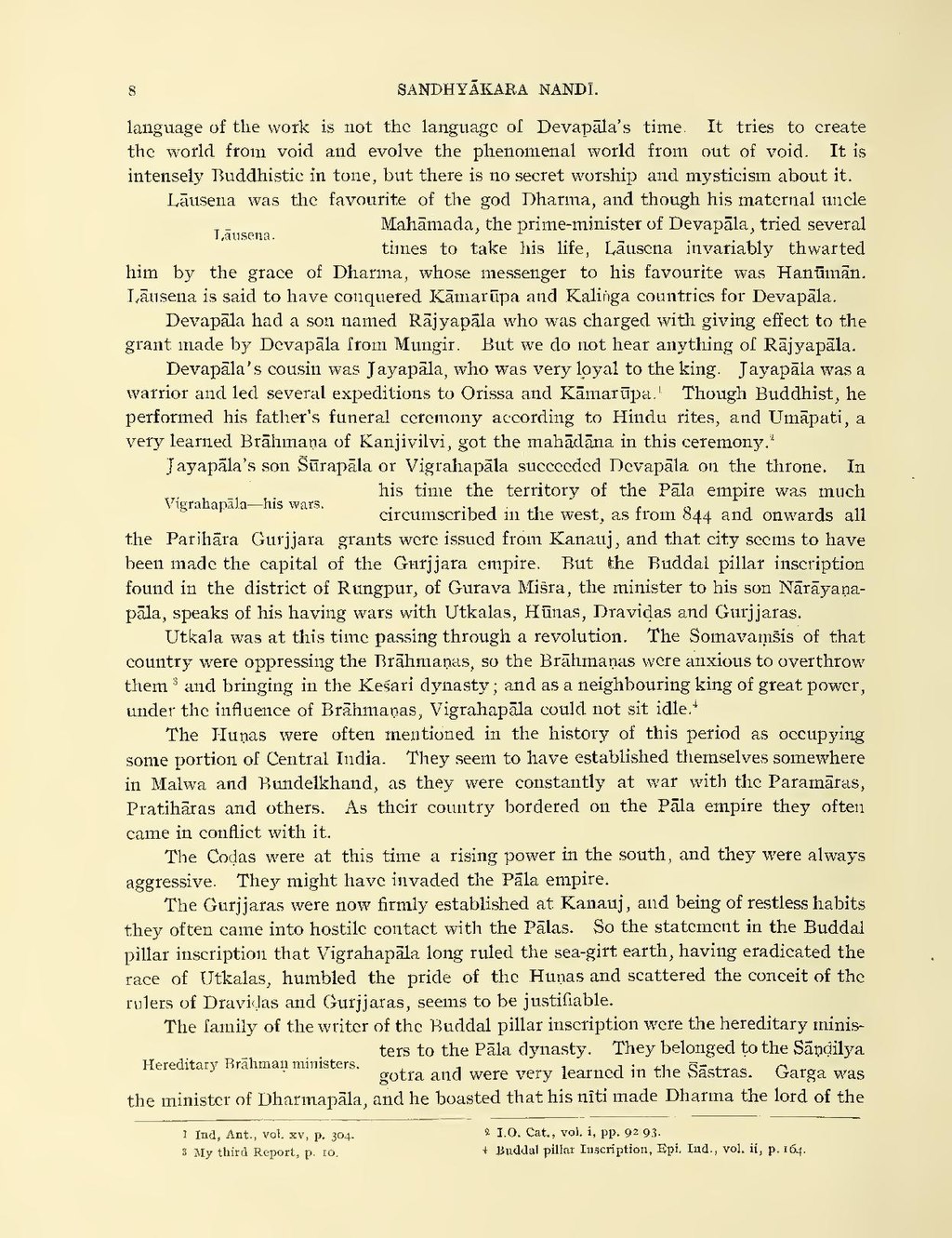SANDHYAKARA NANDI. language of the work is not the language of Devapala's time. It tries to create the world from void and evolve the phenomenal world from out of void. It is intensely Buddhistic in tone, but there is no secret worship and mysticism about it. Lausena was the favourite of the god Dharma, and though his maternal uncle Lausena. Mahamada, the prime-minister of Devapāla, tried several times to take his life, Läuscna invariably thwarted him by the grace of Dharma, whose messenger to his favourite was Hanuman. Lausena is said to have conquered Kamarūpa and Kalinga countries for Devapala. Devapala had a son named Rajyapāla who was charged with giving effect to the grant made by Devapāla from Mungir. But we do not hear anything of Rajyapāla. Devapala's cousin was Jayapala, who was very loyal to the king. Jayapāla was a warrior and led several expeditions to Orissa and Kamarupa. Though Buddhist, he performed his father's funeral ceremony according to Hindu rites, and Umapati, a very learned Brāhmaṇa of Kanjivilvi, got the mahādāna in this ceremony." 8 Vigrahapala-his wars. Jayapala's son Surapala or Vigrahapala succeeded Devapala on the throne. In his time the territory of the Pala empire was much circumscribed in the west, as from 844 and onwards all the Parihara Gurjjara grants were issued from Kanauj, and that city seems to have been made the capital of the Gurjjara empire. But the Buddal pillar inscription found in the district of Rungpur, of Gurava Misra, the minister to his son Nārāyaṇa- pala, speaks of his having wars with Utkalas, Hūnas, Dravidas and Gurjjaras. Utkala was at this time passing through a revolution. The Somavamšis of that country were oppressing the Brāhmaṇas, so the Brāhmaṇas were anxious to overthrow them and bringing in the Kesari dynasty; and as a neighbouring king of great power, under the influence of Brahmapas, Vigrahapala could not sit idle.* The Hunas were often mentioned in the history of this period as occupying some portion of Central India. They seem to have established themselves somewhere in Malwa and Bundelkhand, as they were constantly at war with the Paramaras, Pratihāras and others. As their country bordered on the Pala empire they often came in conflict with it. The Codas were at this time a rising power in the south, and they were always aggressive. They might have invaded the Päla empire. The Gurjjaras were now firmly established at Kanauj, and being of restless habits they often came into hostile contact with the Palas. So the statement in the Buddal pillar inscription that Vigrahapala long ruled the sea-girt earth, having eradicated the race of Utkalas, humbled the pride of the Hunas and scattered the conceit of the rulers of Dravidas and Gurjjaras, seems to be justifiable. The family of the writer of the Buddal pillar inscription were the hereditary minis- ters to the Pala dynasty. They belonged to the Sandilya Hereditary Brahman ministers. gotra and were very learned in the Sastras. Garga was the minister of Dharmapala, and he boasted that his nîti made Dharma the lord of the 1 Ind, Ant., vol. xv, p. 304. 3 My third Report, p. 1o. 2 I.O. Cat., vol. i, pp. 92 93. + Buddal pillar Inscription, Epi. Ind., vol. ii, p. 164.

